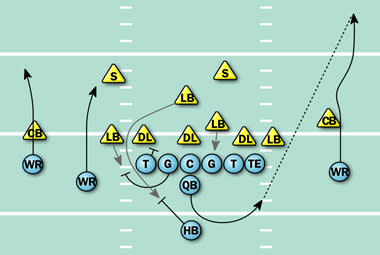Packers need more help up front
Also in this article:
Next Surveillance:
Ravens
More NFL:
Editor's note: Yahoo! Sports will examine the biggest weakness of the 2009 season for every team and explain how the franchise can address the issue. The series continues with the Packers, who finished second in the NFC North (11-5).
Biggest problem in 2009: An offense that deserved better from its offensive line

Aaron Rodgers is sacked by the Vikings' Jared Allen in 2009.
(Tom Olmscheid/AP Photo)
The 2009 Green Bay Packers had an explosive offense with serious fundamental flaws. Quarterback Aaron Rodgers(notes) was a revelation in more than one dimension, putting up the NFL's highest fantasy point total and finishing the season with career highs in every meaningful category (except for interceptions; he dropped that number from 13 in 2008 to 7 in 2009). Running back Ryan Grant(notes) finished second in Football Outsiders' DYAR (Defense-adjusted Yards Above Replacement) metric, which measures season-long, opponent-adjusted efficiency. And all this despite an offensive line that was among the league's most porous. Starting left tackle Chad Clifton(notes) missed four games, including two against the Minnesota Vikings, when end Jared Allen(notes) made Rodgers his personal tackling dummy by amassing 7.5 sacks in just those games. Right tackle Marc Tauscher was signed in early October and started the final eight of the last nine regular-season games, and the wild-card loss to the Arizona Cardinals. But Clifton is 34, and Tauscher is 33, and though the main problems with pass protection came with their replacements in the game, each player has re-signed with the team, but more is needed and development for the future is Job No. 1.
Perhaps the most amazing aspect of Rodgers' 2009 season was his ability to succeed under pressure. He was the second-most hurried quarterback in the NFL last season with 131 hurries in 541 attempts (Washington's Jason Campbell(notes) was hurried 133 times), and Rodgers put up the highest DVOA (Defense-adjusted Value Over Average), Football Outsiders' per-play efficiency metric when under duress than any other quarterback. And it wasn't close. Rodgers' 61.8% above league average DVOA when hurried paced Donovan McNabb(notes), who finished second with 41.0%, and Ben Roethlisberger(notes) with 40.6%. And only the Oakland Raiders and Buffalo Bills allowed more blown blocks leading to sacks, intentional grounding, or offensive holding penalties than did Green Bay's line. It's clear that the Packers' key offensive weapons have learned to produce without optimal protection. But if this team is to leapfrog the Minnesota Vikings, take the NFC North, and make a more serious playoff run, more is required of the five guys up front.
The 2010 solution: Use schooled youth in moderation

Bulaga
Under head coach Mike McCarthy, the Packers have always run zone-blocking variants; the kind McCarthy learned when he was on the Kansas City Chiefs' coaching staff with legendary zone-blocking genius Alex Gibbs. Zone blocking is tremendously effective, but it's far from a panacea when young linemen who are unfamiliar with the concepts try to do what amounts to a very brutal dance. Packers general manager Ted Thompson was aware of the need for younger players who could fit those schemes, and that's why the Packers selected Iowa tackle Bryan Bulaga(notes) with the 23rd overall pick in the 2010 draft. Generally speaking, Green Bay doesn't hold o-linemen up as key cogs – Bulaga was the first first-rounder for the Pack since Ross Verba in 1997 – but these are desperate times. Not only was Bulaga very well-coached by Iowa's Kirk Ferentz, but his familiarity with zone concepts from his college days will put him in a better spot than even more talented linemen who don't understand the specifics of zone blocking and other choreographed ideas. One in Iowa's 2009 30-28 win over the Michigan Wolverines showed how well Bulaga is used to working with other blockers to prevent defensive domination.

In the diagrammed play, which came halfway through the second quarter with the Wolverines up 14-13, Iowa went three-wide against Michigan's quarters coverage. The Wolverines threw a zone blitz on the offensive right side, but the real action was going on over on Bulaga's side of the field. Michigan was in a 3-3 front, with the linebacker outside the right defensive end trying to attack quarterback Ricky Stanzi from a wide set. Instead of blowing the blocking to attack the linebacker, the Hawkeyes' line stayed disciplined, and with everyone holding true to their assignments, Michigan's pass rush was muted. While Bulaga took the right defensive end inside, the left guard pulled out to take the wide linebacker and the blitzing middle linebacker in conjunction with the running back. Because of this, Stanzi had the time to roll right and hit receiver Trey Stross(notes) for a 33-yard gain from the Iowa 26-yard line to the Michigan 41.
There are those who believe that Ferentz-coached linemen are risks in the pro game, because of the possibility that they've been coached to their full potential. But in Bulaga's case, his intelligence, experience, and adaptability could make him more than a swing tackle sooner than later – he could be the key to a line that propels the Packers to the next level.
